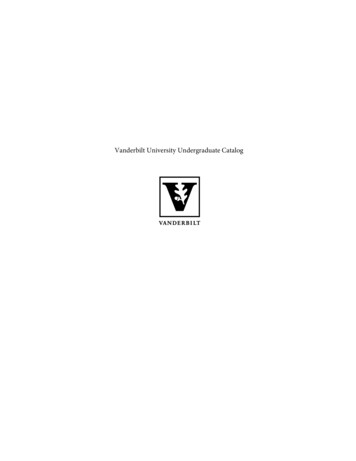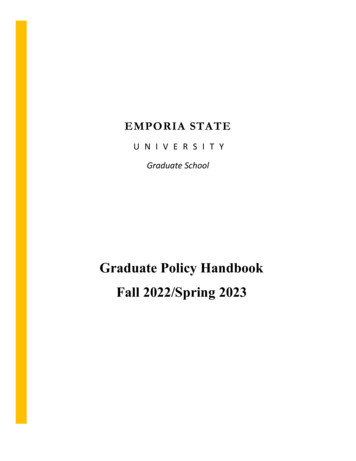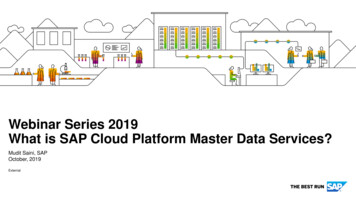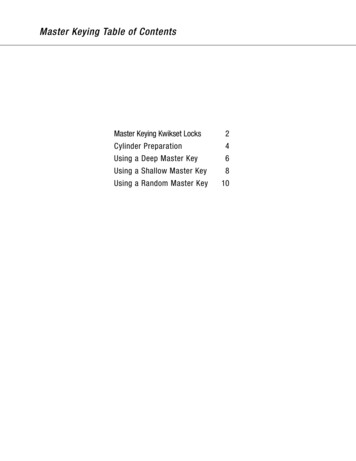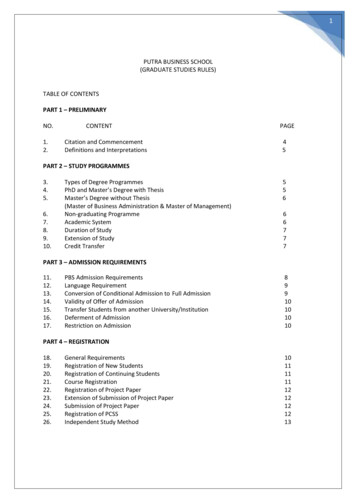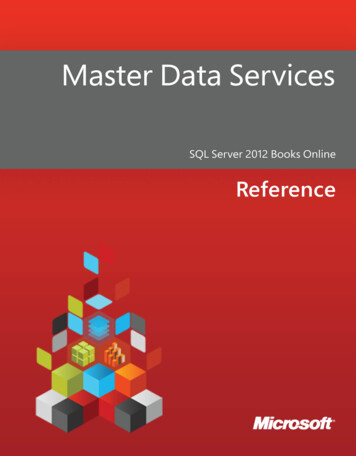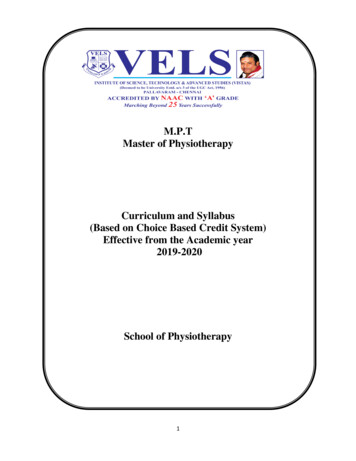
Transcription
M.P.TMaster of PhysiotherapyCurriculum and Syllabus(Based on Choice Based Credit System)Effective from the Academic year2019-2020School of Physiotherapy1
PROGRAM EDUCATIONAL OBJECTIVES (PEOs)PEO1:To provide students with strong fundamental concepts and also advanced techniques tomake them understand about various Physiotherapy approaches.PEO2:To enable MPT graduates to attain successful professional careers by applying theirtherapeutic skills in Physiotherapy treatment & to meet out the challenges in ClinicalArena.PEO3:To engage MPT graduates in persistent learning and pursue research for Clinical decisionMaking & Evidence based practice.PROGRAM OUTCOMEPO1:Graduates of the Master of Physiotherapy program will demonstrate communicationskills to Work creatively and effectively to uphold the professional standards andrelationships with a range of stakeholders like patients, care takers, family members andother clients.PO2:Graduates of the Master of Physiotherapy program will demonstrate cognitive andcreative skills to Critically evaluate and apply physiotherapy approaches, paradigms andtechniques and utilise appropriate, evidence-based skills, techniques and practice inmanaging and treating people with injury, disability or illness in a range of health careand/or rehabilitation settings.PO3:Graduates of the Master of Physiotherapy program will demonstrate technical skills toIntegrate the core areas of physiotherapy practice with emphasis on demonstratedmastery of evidence-based practice, clinical skills, clinical reasoning and decision makingin order to apply creativity and initiative to new situations in professional practice.PO4:Graduates of the Master of Physiotherapy program will demonstrate the broad applicationof knowledge and skills to solve problems individually and independently justifydiagnostic decisions and management strategies on basic of clinical assessment findings.PO5:Graduates of the Master of Physiotherapy program will demonstrate technical skills toapply treatment methods and techniques, to address client needs, safely and withappropriate regard to professional and legislative guidelines, standards and requirements.PROGRAMME SPECIFIC OBJECTIVES (PSOs)PSO1:To inculcate the ability in graduates to assess and treat the patient with AdvancePhysiotherapy techniques.PSO2:To enhance problem solving skills in case study through their clinical training.PSO3:To apply Evidence based practice approach & Clinical Decision making to improve thePhysiotherapy Research.2
BOARD OF STUDIESS. No12345NAMEDr. P. Senthil Selvam, PhDDr. M.S. Sundaram, PhDDr. M. Sandhiya, MPT (Phd)Dr. Priyakumari, MPT (Phd)Dr. Jibe George Varghese,MPT (Phd)AFFILIATIONHead of the Department,School of Physiotherapy,VISTASROLEChairpersonProfessorSchool of Physiotherapy,VISTASInternal MemberProfessorSchool of Physiotherapy,VISTASInternal MemberProfessorSchool of Physiotherapy,VISTASInternal MemberProfessor & PrincipalMenakshi College ofPhysiotherapy,MAHER, ChennaiExternal MemberExternal Member6Dr. C.V. Senthil Kumar,MPT (Phd)PrincipalDr. M.G.R Educational andResearch Institute University,Chennai7Dr. R. Sakthivel, MPTClinical TherapistPerungudi3Alumni
M.P.T - Master of PhysiotherapyCURRICULUMTotal No. of Credits: 100I SemesterCategoryCodeCourseHours/WeekLecture Tutorial PracticalCreditsCore19MPT001Basic Sciences – Theory5004Core19MPT002Allied Sciences – Theory5004Practical19MPT003Physical Rehabilitation- Practical00104Practical19MPT004Movement Mechanics – Viva0054Practical19MPT005Clinical Sciences - Viva0054Total1002020II SemesterBasic PT Interventions – Theory& Practical8026Advance PhysiotherapeuticIntervention – Theory &Practical8026Core19MPT006Core19MPT007ElectiveDSE Elective I5004ElectiveGeneric Elective I5004Total26042080268026III SemesterBasic Fundamentals –Theory &VivaPT Evaluation/ Documentation& Evidence Based PracticeTheory & PracticalElectiveElectiveElectiveDSE Elective II5004ElectiveGE Elective II5004Total2604204
ElectiveIV SemesterAdvance PT Intervention Theory & Practical8026ProjectDissertation001515ElectiveDSE Elective III50041301725TotalCredits by L.T.P.(Including UG Teaching)85Soft Skill/ Clinicals15Total Credits100L – Lectures, T-Tutorial, P – Practical5
List of specialty Electives – for III 00519BMPT00619BMPT007Basic fundamentals in OrthopedicsBasic fundamentals in NeurologyBasic fundamentals in Cardiopulmonary diseasesBasic fundamentals in SportsBasic fundamentals in Hand ConditionsBasic fundamentals in Obstetrics & GynaecologyBasic fundamentals in PediatricsList of specialty Electives – for III 00519BMPT00619BMPT007PT Evaluation/ Documentation/EBP in OrthopedicsPT Evaluation/ Documentation/EBP in NeurologyPT Evaluation/ Documentation/EBP in Cardiopulmonary diseasesPT Evaluation/ Documentation/EBP in SportsPT Evaluation/ Documentation/EBP in Hand ConditionsPT Evaluation/ Documentation/EBP in Obstetrics & GynaecologyPT Evaluation/ Documentation/EBP in PediatricsList of specialty Electives – for IV 00519IMPT00619IMPT007Advance PT Intervention in OrthopedicsAdvance PT Intervention in NeurologyAdvance PT Intervention in Cardiopulmonary diseasesAdvance PT Intervention in SportsAdvance PT Intervention in Hand ConditionsAdvance PT Intervention in Obstetrics & GynaecologyAdvance PT Intervention in Pediatrics6
Dissertation – for IV 00519DMPT00619DMPT007Elective OrthopedicsElective NeurologyElective Cardiopulmonary diseasesElective SportsElective Hand ConditionsElective Obstetrics & GynaecologyElective PediatricsList of Discipline Specific Elective PT10619MPT107Clinical testingErgonomicsFood and NutritionEnglish for communicationComputer & its application in PTBiostatistics / Research MethodologyApplied PhysicsGeneric Elective diopulmonary resuscitationClinical diagnosisPT EvaluationApplied ChemistryHospital Management7
SyllabusCore Courses8
19MPT001BASIC SCIENCES5 0 04Course Objective:The objectives of this course is that after 100 hours of lectures & demonstrations, in additionto clinics, the student will be able to understand the basic knowledge about the applied anatomyand applied physiology of various systems of the body, biomechanics & pathomechanics,nutrition, fitness & PT ethics.This paper consist of the following 5 modules1.2.3.4.5.Applied AnatomyApplied PhysiologyMovement ScienceExercise Physiology & NutritionPT Ethics / Education TechnologyCourse Outcomes:1. This provides a detailed introduction on applied anatomy and applied physiology ofdifferent systems of the body2. This course explains the structure and function, forces that affect motion and the resultantkinematics.3. This gives better understanding of physiological mechanisms and organ systems thatallow humans to engage in physical activity4. This provides detail lecture on bio mechanics and pathomechanics of each joint.5. This provides basic guideline to education system, teaching methodology, curriculumframing, guidance and counsellingUNIT IAPPLIED ANATOMY1. Cytoskeleton2. Cardiovascular system3. Respiratory system4. Muscular system5. Urinary system6. Skin & sense organs7. Lymphatic system8. Nervous system9. Skeletal system10. Endocrine system11. Digestive system12. Reproductive system920
UNIT IIAPPLIED PHYSIOLOGY20I) THE HEART AND CIRCULATIONa)b)c)d)e)f)g)Structure and properties of heart musclesThe action of the heartDeterminants of cardiac performanceNormal E.C.GMaintenance of blood pressureCardiac arrest and heart failureOutline of lymphatic circulation and pulmonary circulation Cardiovascular compensationfor postural and gravitational changesh) Hypertensioni) Edemaj) Central and peripheral venous pressureII) NERVOUS SYSTEM AND MUSCLESa)b)c)d)e)f)g)h)i)j)k)l)Outline the structure and function of the central nervous systemOutline the autonomic nervous systemTypes of nerve cells, electrical phenomena in nerve cellsProperties of mixed nervesReflex action, reciprocal innervationsDegeneration and regeneration of nervesControl of postureOutline of voluntary movementCutaneous, deep and superficial sensationsSynaptic transmissionNeuromuscular transmissionProperties of muscles, contractile responses, types of contraction, electrical phenomenaand tonic reflexesIII) RESPIRATIONa)b)c)d)e)Mechanics of respirationBreath soundsProperties of gasesExchange of gasesGas tension in air at sea level, tracheal air, cellular air, mixed air, plasma, arterial bloodand mixed venous bloodf) Lung volumeg) Magnitude of dead spaceh) Control of bronchial smooth musclei) Lung compliancej) Nervous control of respirationk) Chemical control of respirationl) Voluntary control of respirationm) Oxygen and CO2 transportn) Acid - base reactions in blood10
o) Effects of exercise on respirationp) Artificial respirationUNIT IIIMOVEMENT SCIENCE20BIOMECHANICS AND PATHOMECHANICS1. BASIC MOVEMENT TERMINOLOGYa. Core areas of study – Anatomy functional, Anatomy, Biomechanics, Kinesiology, Linearmotion, angular motion, Kinematics, Kinetics, Static and Dynamic.b. Anatomical movement description – segmental names, anatomical terms, Movementdescriptions – basics and specialized.c. Relative systems – relative – Absolute. Planes/ Axis.d. Characters of joint movement – Single and multiple joint movements.2. SKELETAL CONSIDERATION OF MOVEMENTa. Functions of skeletal systemb. Types of bonesc. Bio mechanical characteristics of bones: Bone tissue, architecture of bone, strength andstiffness of boned. Types of load, Bony articulationse. Types of joins and its descriptions such as diarthrodial or synovial etc.3. MUSCULAR CONSIDERATION FOR MOVEMENTa. Structure of muscle, Physical organization of muscle, Fiber organization, Fiber type,Muscle attachment.b. Functional characteristics of muscles, muscle fiber potential. Functions of Muscles, Roleof Muscle, Mechanical components in the muscle, Net muscle action. Factors influencingmuscle force. Angle of attachment of muscle. Length – tension relationship, forcevelocity relationship, stretch shortening cycle, one and two joint muscle. Extra andintrafusal muscle fibers, Action potential, evoke potential ,kinetic potential, Tongue,Power strength & Endurance.4. NEUROLOGICAL CONSIDERATIONS FOR MOVEMENTa.b.c.d.e.f.g.General organization of nervous systemMotor neuronsStructure of the motor neuronMotor unitFunctional characteristics of motor unitMeasurement of motor unit activitiesSensory neurons, Functions of neural control, Reflex arc, myotonic, proprio spinal andsupra spinal reflexes, sensory receptors- muscle spindle – nuclear chain fibers. Gammaand fusimotor. Innervations Golgi tendon organ (GTO) joint receptors.11
5. FUNCTIONAL ANATOMY:Classification of joints (Natural, Anatomical & Kinesiological)a. Upper extremityb. Lower extremityc. The trunk (spine)Upper LimbShoulder Jointa.b.c.d.e.f.g.Gleno humeralJoint type, movementScapulo thoracicAcromioclavicularSterno - clavicularDynamic & static stabilityScapulo humeral rhythmElevators & Depressors of shoulder girdleElbow jointa. Types motion, axis of motion, mechanism & muscle producing movement.Radioulnar jointa. Type, motion, axis of motion muscles producing movementWrist jointa.b.c.d.e.f.g.Type, motion, axis of motionMechanism of extension, radial deviationLumbrical mechanismInterossei mechanismFlexor, extensor mechanismCMC, MCP, IPS – type, motion & mechanismPrehension activitiesLower limbHip jointa.b.c.d.e.Type, axis of motionPelvic & femoral motionUnilateral, bilateral stance – stability & weight distributionReduction of forces using canesMuscles producing movement12
Knee jointa. Type, axis of motionb. Movement of Tibiofemoral & patellafemoral jointc. Muscles producing movementsAnkle jointTypes of axis of motion arthro & osteokinematicsa. Subtalar jointb. Transverse jointc. Tarsal jointd. MTP jointe. IP jointf. Plantar arches & their functionsTrunka. Vertebral column – structure of function & different types of vertebraeb. Ribs – structure of function of various joints involved in thoracic cagec. Types of movements taking place during respiration6. PATHOMECHANICS & PATHOKINETICS OF PARALYTIC DISABILITIESa. Joints of Upper extremityb. Joints of Lower extremity. The trunk (spine)Upper limbShoulder jointParalysis of trapezius, Serratus anterior, Rhomboids deltoid, supraspinatus, sub clavius,pectoralis major & Latissimus dorsia. Operation for paralysis of trapezius, serratus - anterior & deltoidElbow jointa.b.c.d.e.Paralysis of elbow extensions, flexorsMethods of transposition of forearm muscleSubstitution by tricepsNurse maids elbow, students elbowCubitus varus, valgusWrist jointa.b.c.d.e.Paralysis of finger flexor, extensors, lumbricals, interosseiImplantation of flexors & extensorsArthrodesis of wrist with tendon transplantationTrigger fingerDe Quervain’s tenosynovitis13
f. Mallet fingerg. Claw fingerHipa.b.c.d.Kneea.b.c.d.e.f.g.h.Coxa vara, coxa valga, dysplasia of hip joint pelvic obliquityParalysis of hip abduction, adductors, extensors flexors, internal & external rotatorsReconstructive procedure of paralysed hip joint – paralytic conditions, shelving operationSubstitution of abductorsGenu valgum, genu varum, recurvatumTibial torsionPatella alta & BajaLateral dislocation of patellaParalysis of extensors, flexorsFasciodesis , Tenodesis, Osteoplastic arthodesisReconstruction of paralytic genu valgusReconstruction of flexor contractureAnkle & Foota. Pronated footb. Pes planusc. Pes cavusd. Paralysis of dorsiflexors, Plantorflexors, invertors, evertors, intrinsic muscles of foote. Transplantation of muscles for paralysisTrunka.b.c.d.e.f.g.h.i.Paralysis of neck, trunk flexors, extensors lat flexors & RotatorsDisc prolapseSpondylosis, Spondylitis , ebraPigeon chestBarrel chestUNIT IVEXERCISE PHYSIOLOGY & NUTRITION1. Nutrition – the basis for human performancea. Carbohydratesb. Lipids & Proteinsc. Vitaminsd. Minerals and watere. Optimal Nutrition for exercise.1420
2. Energy for physical activity –a. Energy Value of foodb. Introduction to energy transfer, energy, transfer in the body phosphate bond energy,energy released from foodc. Energy transfer and exercised. Measurement of human energy expendituree. Human energy expenditure during rest and physical activityf. Energy expenditure during walking, jogging running and swimming3. System of energy delivery and utilization: the cardiovascular system cardiovascular regulationand integration functional capacity of cardiovascular system.4. Dynamics of pulmonary ventilation: Regulation of pulmonary ventilation, pulmonaryventilation during exercise, acid – base regulation.5. Enhancement of energy capacitya. Training anaerobic and aerobic powerb. Muscular strength Training muscles to become stronger strength measurements andresistance training, structural and functional adaptation to resistance trainingc. Special aids to exercise training and performance6. Exercise performance and environmental stressa. Exercise at medium and high altitudeb. Exercise and thermal stress – Mechanism of thermoregulation. Thermoregulation andenvironmental stress during exercisec. Sport diving7. Body composition assessment, physique. Performance, and physical activity, overweight,Obesity and weight control.8. Exercise in aging and disease prevention.9. Physical Activity in healthy aginga. Physical activity in the populationb. Aging and physiologic functionc. Physical activity, health and longevityd. Coronary heart disease.10. Clinical Exercise physiology for cancer, obesity HT, DiabetesUNIT VPT ETHICS / PT EDUCATION TECHNOLOGY1.Educational aims.Agencies of Education.Current issues and trends in education.2.Concepts of teaching and learning.Theories of teaching.1520
Relationship between teaching and learning.Psychology of Education.3.Physiotherapy Curriculum.Committee, development, types, current trends and curriculum planning.4.Principles and methods of teaching.Strategies of teaching.Organizations, writing lesson plans.5.A V Aids.Measurement and evaluation.Meaning, Process, Standard and Nonstandard Tests.6.Guidance and counseling.For students and faculty.7.Faculty development for PT services.P T ETHICSPT Ethical Issuesa.b.c.d.Ethical Rules of IAP and WCPT.Rules & Regulations of IAP.Objective of IAP.documentationPhysiotherapy and Law / Medico legal aspectsa.b.c.d.e.Medico-legal aspects of physical .Total Hours:100Textbooks:1. Guyton, Text book of Physiology Elsevier, 4 Ed, 20002. Tora Tora , Textbook of Anatomy & Physiology, Churchill Livingston, 3 Ed, 20043. Chatterjee, Text Book of Physiology. JP, 2 Ed, 200116
References:1. Grays Anatomy, mosby, 2Ed, 19942. Derek, Anatomy, Palpation and surface Marking, Elsevier, 4Ed, 19973. Sieg, Illustrated essentials of musculoskeletal anatomy, CBS, 2Ed, 19954. Nigel, Anatomy and human movement , MCGH, 4 Ed, 20005. T.S. Ranganathan , Textbook of anatomy, JP, 3 Ed, 19996. Palastanga , Anatomy and human Movement JAYPEE, 2 Ed, 20037. Cynthia. C.Norkin, Pamela , K.Levengle Joint structure & function, ELBS, 4 Ed, 20048. Axen, Illustrated Principal of exercise physiology, CBS, 1 Ed, 20009. Katch, Exercise physiology energy nutrition and human performance ELSEVIER, 4Ed, 200610. Frank, Exercise Physiology for health care professionals, mosby, 4 Ed, 199911. Power, Exercise Physiology.ELBS, 2 Ed, 200112. U. Sathyanarayana, Essentials of Biochemistry –Book and Allied (P) Ltd, Kolkatta.1 Ed,200213. S.D.Seth, Text Book of Pharmacology, Churchill Livingstone.2 Ed, 200514. K.D.Tripathi, Essentials of Medical Pharmacology, JayPee Brothers 4 Ed, 200917
19MPT002ALLIED SCIENCES5 0 04Course Objective:The objectives of this course is that after 100 hours of lectures & demonstrations, inaddition to clinics, the student will be able to understand the basic knowledge about the statistics,research, management, bio chemical activities in human body, pathology & pharmacology.This paper consists of 5 Modules1.2.3.4.5.Biostatistics and Research MethodologyManagement / Administration / MarketingBio-chemistryMicro biology & PathologyPharmacologyCourse Outcomes:1. The students can able to understand and make use of several statistical tools necessary forvarious statistical analysis2. Understands the principles, policies, administration, record maintenance, performanceanalysis of health sector management.3. Analyze the policies, procedures, recruitment, department planning and principles ofphysiotherapy practice.4. Knowledge about the microorganism, natural & acquired immunity, treatment and preventionof the various infections5. Extensive details regarding the basic pharmacology of various common medication used andits effect on patient and during physiotherapy.UNIT IIBIO STATISTICS & RESEARCH METHODOLOGYUses of statistical methods in PT1) Measurement, measurement scales, variables & their measurements.2) Symbolizing data & operations.II Statistical Tools1)2)3)4)5)Statistical dataTabulationCalculation of central tendency & dispersionLinear regression & correlationPresentation of data in diagrammatic & graphic form.III Probability & sampling1) Probability as a mathematical system1820
2)3)4)5)Population & samplesSampling distributionSampling methodsSurveys in researchIV Vital & Health statistics1) Uses of vital & health statistics in practice of PT2) Sources & methods of collection & recording3) Interpretation of commonly used vital & health statistics & estimate population usingarithmetic progression methodV Research MethodologyI. IntroductionImportance of research in physiotherapy.Ethics in physiotherapy research.Introduction to the conceptual, empirical, interpretative, quantitative and qualitative research.II. Conceptual PhaseFormulation of the problem.Concepts and variables.Literature review.Hypothesis.III. Empirical/Conducting PhaseResearch design.Brief overview of qualitative and quantitative approaches.Population and samplesCollection of data.Research data and analysis.IV. Interpretative PhaseDiscussion and conclusions.Interpreting qualitative results.V. Criticizing published resultsNeed for criticizing results.Guidelines for criticizing results.VI. Writing research for publicationGuidelines for writing results.Recent trend in researchUNIT IIMANAGEMENT/ADMINISTRATION/MARKETINGManagement studies for Physiotherapy1. Definition – Branches of management- Principles of health sector management.2. General principles of management: Theories of management.1920
3. Management studies related to local health care organization management & structureplanning delivery with quality assurance & funding of service delivery – informationtechnology – Time management –career development in physiotherapy - preparing for 1st jobetc.,4. Personnel management: Policies and procedures. Basic concepts and theories.5. Resource and quality management: planning with change and coping with change.6. Performance analysis – physical structure / reporting system (man power / status / function/quantity & quality of services / turn over – cost benefit – revenue contribution.7. Administration – principles – based on the Goal & functions – at large hospital set updomiciliary services / private clinic / academic.8. Methods of maintaining records9. Financial issues including budget and income generation.10. Principles of an organizational chart11. Organization of a department: Planning, space, manpower, materials andbasicRequirements and recruitment, policies and procedures.12. Infrastructure in various departmental / segmentalP T Department Managementa.b.c.d.Policies and procedures.Recruitment.Department PlanningPrinciples of practiceUNIT – IIIBIO-CHEMISTRY20I. Energy SourceCarbohydrates.Fats.Proteins.II. EnzymesSpecificity and factors affecting enzyme activity, intracellular and extracellular enzymes, clinicalsignificance of alkaline phosphatase, acid phosphatase, cholinesterase and creatinephosphokinase.III. Metabolic pathways related to carbohydrate lipid and protein metabolismDisorders of metabolism and related bio-chemical changes.IV. Bio-chemical changes during muscle contractionV. PHControlling factors and bio-chemical analysis.VI. Physical stress and lactate levels20
UNIT IVMICROBIOLOGY / P.Q.Introduction: Concepts of disease, classifications of lesions.Bacterial, viral and parasitic infections a general outline.Inflammation and repair, Degeneration, necrosis and gangrene.Haemorrhage, shock, embolism, thrombosis.Tuberculosis, leprosy, typhoid.Deficiency diseases.Tumours: Aetiology & spread. Common tumour.Blood: Anaemia, Heart and blood vessels, Common congenital anomalies, Rheumatic &coronary heart diseases.Respiratory system: Pneumonias, Bronchiectasis, Emphysema, Chronic bronchitis, Asthma.Bone and joints: Autoimmune disease, Septic arthritis, Osteomyelitis.Skin: Leprosy.Urinary system.Central nervous system: CNS infections, vascular disorders.Rheumatoid Arthritis.Scleroderma and Psoriasis.Diseases of muscle including Poliomyelitis, Myopathies.Volkmann's ischemia.MICROBIOLOGYA. Introduction and history of microbiology.B. General lectures on micro-organisms:1. Classification.2. Shape and arrangement.3. Special characteristics - spores, capsules, enzymes, motility, reproduction.a. Disinfection and antiseptics.b. Sterilisation and asepsis.c. Antibacterial agents - fundamental aspect. Susceptibility testC. Immunity - natural and acquired.1. Infection - source of infection.- portals of entry,- spread of infection2. Non- specific immunity3. Allergy and hypersensitivity.4. Outline of common pathogenic bacteria and the diseases produced by them.Treatment and prevention:a. Respiratory tract infections.b. Meningitis.c. Enteric infections.d. Anaerobic infectionse. Urinary tract infections.f. Leprosy, tuberculosis and miscellaneous infections.21
g. Wound infections.h. Sexually transmitted diseases.i. Hospital acquired infections.D. Pathogenic Yeasts and fungi.E. Virology -Virus infections, with special mention ofHepatitis, Poliomyelitis & Rabies.UNIT VPHARMACOLOGY20Introduce the students to basic pharmacology of various common medication used and itseffects on patients and during physiotherapy.A. TerminologyB. Classification of drugsC. Factors influencing the dosage of drugs and its actions.D. Drug AllergyE. Principles of drug administration and routes.F. Definition, action, indications, contra - indications, adverse reactions of the mmatoryAnti-epilepticSedatives, Hypnotics, TranquilizersMuscle relaxantsAlcoholPulmonary effects of general anaesthetic agentsMucolytic agentsLocal anaesthetic agentsNarcotic SteroidsVasodilatorsInsulin and oral hypoglycemic agentsAntibiotics – Bactericidal, BacteriostaticChemotherapeutic drugs in leprosy and tuberculosis.EvaluationTotal Hours:100Textbooks:1. Poddar S., Introduction to Research in Health Sciences, Churchil Livingstone, 3rd edition,19882. Currier D.P., Elements of Research in physical therapy, Williams & Wilkins, Baltimore,3rd edition 19903. Sundar Rao & Richard, An introduction to biostatistics, JP, 2nd edition, 20084. Elaine Lynne, Management in Health Care, Macmillan Publisher, 3rd Edition,2000.5. Willam A. Reinke, Health Planning for Effective Management, Oxford University Press,1stEdition, 199622
References:1. Ashok Neeraja, Nursing Education, JP, 3rdEdition, 20112. Madhavan Nair, Education Methods, Jaypee, 4thEdition, 20093. Carolin Hicks, Research for physiotherapist, Mosby, 2ndEdition, 20064. Barbara, Statistical methods for healthcare research, Churchill Livingston, 1stEdition, 19955. Barlene: Documenting functional outcomes in physical therapy., McGrawhill, 4thEdition, 199923
19MPT003PHYSICAL REHABILITATION0010 4Course Objective:After 200 hours of clinical practice, students should be able toi) Explain the concepts and principles of various Rehabilitation approaches.ii) Demonstrate assessment of patients using various Principles.iii) Analyze the patient’s problems and come to a clinical diagnosis.Course Outcomes:1.2.3.4.5.One can understand about the significance & importance of history taking.The clear understanding of orthopaedic rehabilitation can be attainedThe clear understanding about the knowledge of cardiac rehabilitation can be attainedThe clear understanding of pulmonary rehabilitation can be attainedThe clear understanding of neurological rehabilitation can be attainedUNIT IINTRODUCTION1.2.3.4.UNIT IIAssessment and treatment planningValue of patient careSignificance of history takingImportance of physical rehabilitation in communityORTHOPAEDIC REHABILITATION1.2.3.4.5.UNIT III40Musculoskeletal assessmentGait analysisPerambulation and gait trainingRehabilitation management in arthritisAmputation managementCARDIO AND PULMONARY REHABILITATION1.2.3.4.5.40Cardio respiratory assessmentExercise prescriptionPulmonary rehabilitationCommunity based rehabilitation for pulmonary diseases patientsVital signs.2440
UNIT IVNEURO LOGICAL REHABILITATION1.2.3.4.UNIT V40Neuro assessmentStrokeSpinal cord injuryAssessment and intervention strategies for cognition and perceptualdysfunction for neuro patientsGERIATRICS AND OBG1.2.3.4.40Role of physiotherapy in women health and OBGSignificance of exercise prenatal, antenatal and postnatal stagesCommon gynecological problemsGeriatric rehabilitationEvaluationTotal Hours: 200Text books:1. Janet H carr, a motor re leaning programme for stroke, aspen publishers, 2nd, 19872. Berta bobath, adult hemiplegia, butterworth Heinemann, 3rd ed, 1990.Reference:1. David J. magee, orthopeadic physical assessment, saunders , 5th ed, 2008.25
19MPT004MOVEMENT MECHANICS005 4Course Objective:After 100 hours of clinical practice, students should be able to explain & demonstratefunctional anatomy, biomechanics, pathomechanics & gait pattern of various clinical conditionsCourse Outcomes:1. One can understand about the kinetics & kinematics of body2. The functional anatomy of upper extremity, lower extremity trunk can be well understood3. The biomechanical knowledge of various – musculoskeletal system can be understood4. The pathomechanics of upper limb lower limb & trunk can be well known5. The gait & its determinants can be very well understoodUNIT IINTRODUCTION1.2.3.4.5.UNIT II20KineticsKinematicsPlanes and axisLinear and angular motionClassification of jointsFUNCTIONAL ANATOMY201. Upper extremity2. Lower extremity3. TrunkUNIT IIIBIO MECHANICS1.2.3.4.UNIT IV20Bio-mechanical characteristics of bone, soft tissue, articulation etcTrabecullar systemMuscular consideration of movementNeurological consideration of movementPATHOMECHANICS201. Pathokinetics of upper limb2. Pathokinetics of lower limb3. Pathokinetics of trunk26
UNIT VGAIT1.2.3.4.20Determinants of gaitGait cycleLocomotive training and aidsPathological gaitEvaluationTotal Hours: 100Text books:1. Janet H carr, a motor re leaning programme for stroke, aspen publishers,2nd , 19872. Berta bobath, adult hemiplegia, butterworth Heinemann, 3rd ed, 1990.Reference:1. David J. magee, orthopeadic physical assessment, saunders , 5th ed, 2008.27
19MPT005CLINICAL SCIENCES005 4Course Objective:After 100 hours of clinical practice, students should be able to explain & demonstratebiochemistry, pathology, microbiology& pharmacology involved in various clinical conditionsCourse Outcomes:1.2.3.4.5.The energy source can be well understoodThe biochemical analysis & standard levels can be knownThe knowledge of pathology related to various condition can be gainedThe allergic & immunity for various agents can be well understoodThe pharmacology for various conditions diseases can be understoodUNIT IINTRODUCTION1.2.3.4.UNIT I2
School of Physiotherapy . 2 PROGRAM EDUCATIONAL OBJECTIVES (PEOs) PEO1: To provide students with strong fundamental concepts and also advanced techniques to . PSO3: To apply Evidence based practice approach & Clinical Decision making to improve the Physiotherapy Research. 3 BOARD OF STUDIES S. No NAME AFFILIATION ROLE 1 Dr. P. Senthil Selvam, PhD



